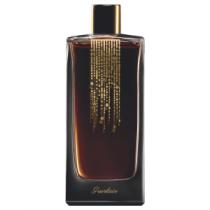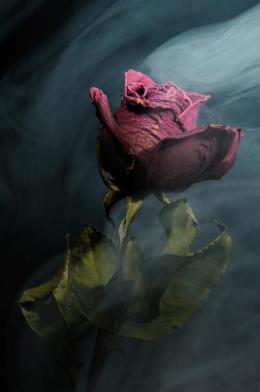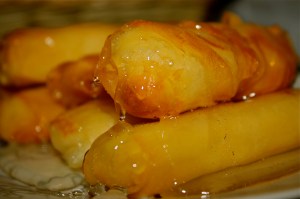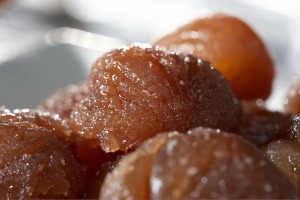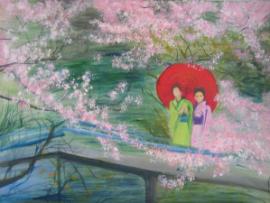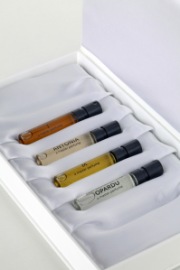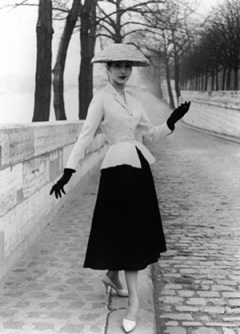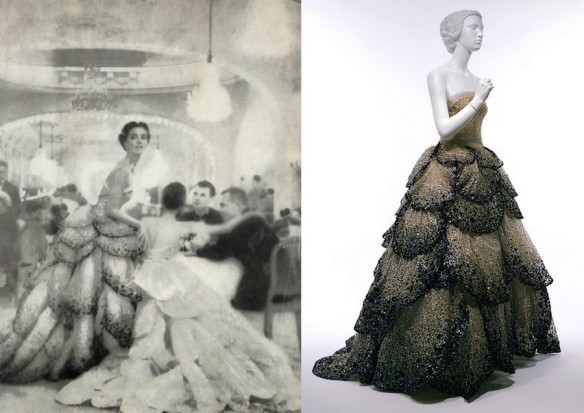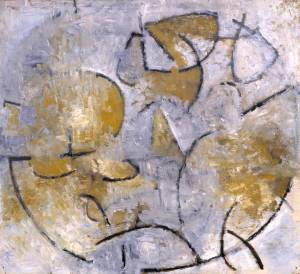The treasures of the Middle East, opulent orientals, and Guerlain’s incomparable style — it’s hardly surprising that I was over the moon to try Guerlain‘s exclusive Les Deserts d’Orient collection. Featuring a trio of perfumes created by Thierry Wasser (Guerlain’s in-house perfumer and creative director), the line was released in mid-2012 exclusively for the Middle Eastern market before subsequently making its way to a few select Guerlain stores and retailers in Europe and America.
I was even more excited when I read Fragrantica‘s description of the perfumes:
Straddling the line between contemporaneous sensibilities and antique exotic traditions, the newest collection Les Déserts d’Orient by Guerlain has the patina of aged woods and bronze artifacts hiding in some cave in the desert, yet its Frenchiness is undeniably there too.
Clearly, this was a trio that I had to try. I’ve barely concealed my enormous disappointment over many of Guerlain’s modern perfumes with their endless sweetness, their occasional thinness, and their lack of great nuance. In my opinion, if one were to compare the vintage versions of the legendary Guerlain classics with their sultry richness, incomparable sophistication, endless nuances and stunning layers to much of the current crop, the difference would be as wide as a chasm. But I was convinced that Les Deserts d’Orients collection would change that feeling.
I started with Rose Nacré du Desert (Pearly Rose of the Desert) and was thrilled at the opening. There was hope! Then, alas, began the now-usual descent into enormous sweetness, with heaping mounds of sugar that verged on the gourmand. Rosé Nacré du Desert turned out to be the bastard child of an Oriental and a Gourmand which makes it far from my cup of tea — though it is a pleasant perfume and a very tame, neutered oriental which will be perfect for gourmands who fear any sort of spice.
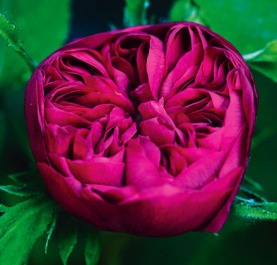
“Rose de Rescht,” a type of Persian damask rose which originated from Rascht, Iran. Source: Flowerpedia.blogspot.com
Almost all descriptions of the perfume’s notes begin with some variation on the words “a lush, dewy Persian rose.” According to a review of Rose Nacrée by Clayton of What Men Should Smell Like, Thierry Wasser “personally sourced a Damask rose from Iran and it is seen here for the first time in a Guerlain perfume.” Elsewhere, Thierry Wasser is quoted as saying that the rose was “savage” and dark. But there is more to Rose Nacrée than just the Persian flower. The most complete set of notes that I could find came from Surrender to Chance, which also includes:
smoke, amber, saffron, cardamom, agarwood/oud, benzoin, patchouli and myrrh.
The opening for Rose Nacrée was lovely. It was a dirty, darkened, black rose, tinged with smoke. There was also oud which, initially, had a medicinal touch before softening, within seconds, to something smoother and milder. Cardamom covered the petals, along with saffron. At first, the saffron was not sweet, dessert-like and yellow-orange the way it often is; instead, it was fiery and chili-pepper red in hue, adding a wonderfully spicy touch. There was a wonderfully nutty, almost toffee-like richness to the notes in those opening minutes. After a brief while, the rose becomes a little sweeter, a little more honeyed and much less black. It’s still gorgeously dirty, but sugar, vermilion and beefy red start to infuse the petals. It reminds me of the dark talons of Chinese empresses that you would see in the movies.
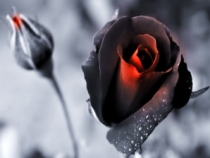 As the minutes pass, more and more red infuses that black, smoked rose which now starts to gleam like a blood ruby in the light, reflecting different facets of sweetness, spice, woody oud, amber and smoke. Rose Nacrée du Desert is a bit like reverse animation where the dying, wizened, blackened rose trails wisps of smoke before starting to spring back to life, straightening up, plumping up, turning more and more red by the minute. As it starts to re-awaken and bloom, it first oozes drops of darkened black-red, then treacly, thickly sweetened red, before finally, golden amber. Its dark thorns reflect brown wood, cardamom, and almost a suggestion of leather; the smoke dissipates; and all that remains is a candied, pearly, iced rose on a base of golden brown.
As the minutes pass, more and more red infuses that black, smoked rose which now starts to gleam like a blood ruby in the light, reflecting different facets of sweetness, spice, woody oud, amber and smoke. Rose Nacrée du Desert is a bit like reverse animation where the dying, wizened, blackened rose trails wisps of smoke before starting to spring back to life, straightening up, plumping up, turning more and more red by the minute. As it starts to re-awaken and bloom, it first oozes drops of darkened black-red, then treacly, thickly sweetened red, before finally, golden amber. Its dark thorns reflect brown wood, cardamom, and almost a suggestion of leather; the smoke dissipates; and all that remains is a candied, pearly, iced rose on a base of golden brown.
It sounds lovely and, for those who love gourmand perfumes, it most certainly will be a huge hit. But this “pearly” rose gets its sheen through icing and endless globs of sugar. Rose Nacrée’s sweetness intensifies in as little as twenty minutes, taking on a very gourmand feel. The saffron completely changes from spicy to something reminiscent of desserts.
In conjunction with the cardamom and the slightly nutty amber, the result evokes Middle Eastern sweets drenched in thick honey or syrup and filled with nuts. The whole thing sits upon a rich, burnished leather base, tinged with smoke and a soft oud, but none of those can really alter the fundamentally sweet nature of this heavily sugared rose. For my personal preferences, I far preferred it when it was a dirty, blackened rose with lovely smoke.
An hour in the Rose Nacrée’s development, the patchouli starts to make itself noticeable. It’s neither the black, slightly dirty, smoky patchouli of the ’70s nor the very purple patchouli common to many mainstream fragrances today. Instead, it almost feels mossy, as if a symbolic touch of green much like a rose’s stem. Taking the analogy further, the slow start of the myrrh resin, along with the cardamom and quiet hint of wood, would constitute the thorns. At the 90 minute mark, the perfume is fundamentally a very (very) sweet rose and saffron scent over a dusky wood foundation with almost a hint of light musk.
There was a candied note to the perfume that I could not place and which I struggled to identify from the start. It wasn’t exactly nutty toffee, it definitely wasn’t caramel, but it was something dessert-like. Then, I read Bois de Jasmin‘s review for Rose Nacrée du Desert where she said that the mossy drydown of the perfume was “reminiscent more of Caron Nuit de Noël with its dark undercurrent” than of the classic Guerlainade found in things like Shalimar or L’Heure Bleue.
That reference to the famous Nuit de Noel was genius and brilliant. It instantly clarified that note in Rose Nacrée which I could not immediately place: it was marron glacé or candied, iced chestnuts. As Wikipedia will tell you, marron glacé is a chestnut candied in sugar syrup and then glazed. As a child living in France, it was (and always will be) a huge guilty pleasure of mine. (And, frankly, blog references to marron glacé are the sole reason why I blindly purchased a bottle of Nuit de Noel, only to find that the non-vintage version was a sad cry from that I had expected.) In Rose Nacrée, the base has a definite note of marron glacé, but it is far stronger than in Nuit de Noel and verges almost on a candied, nutty, chestnut syrup.
As time passes, the perfume’s inflections wax and wane, with certain notes gaining in individual strength for a few moments before again receding. Clearly, this is a beautifully blended perfume. As the dry-down phase begins, sometimes the oud shines forth, sometimes it is the amber, or the plush, velvety patchouli — but all the notes lie in the shadow of that candied, syrupy rose with iced chestnuts. In Rose Nacrée’s final hours, it turns into a chestnut-y amber with benzoin, a wisp of oud, and a faint trace of powder.
The perfume is pretty, but I found it underwhelming. It is, ultimately, a very simple perfume at heart: highly sweetened rose with oud and saffron. I’ll spare you my increasingly cantankerous views of Guerlain’s headlong descent into overly sweet, sugary perfumes and just tell you that, in my opinion, there are far better perfumes that use the rose, oud, saffron, cardamom and amber combination. At the top of that list would be the spectacular, infinitely more complicated, and complex Trayee by Neela Vermeire Créations. It is not only a “spicy oriental” in the true sense of that term, but it uses those same notes to much greater effect to create an utterly ravishing, sophisticated, highly nuanced perfume. (It probably helps that Trayee has about 11 more notes as well.)
Even if we set aside the more complex Trayee, there are an endless number of perfumes with some combination of Rose Nacrée’s notes. Whether it’s Montale‘s Aoud Safran (which also has rose), By Kilian‘s Rose Oud, L’Artisan‘s Safran Troublant, Dior‘s Oud Isphahan, or Amouage‘s Epic For Women (to which Rose Nacrée has sometimes been compared) — the point is, this ground has been hoed before. While I think Guerlain’s interpretation is richer, heavier and more nuanced than both Kilian’s lighter, more anemic, interpretation or the Montale, Rose Nacrée is still neither a particularly original perfume nor, in my opinion, a brilliant one.
I will be the first to admit that my dislike for gourmand fragrances and my love for true, spicy Orientals are influencing my assessment. But I am not alone in how I see the perfume. Fragrantica itself in its early assessment of the trio called Rose Nacrée “[a]rguably the less ‘original’ in the trio” before writing
[t]he sweetness is pervading, even more than the previous Deserts d’Orient examples, with nuances of loukhoum rosewater and copra powder enrobing the yummy delicacy. The mouth-watering gourmand quality is very Guerlain; rose and sugar are eager bedfellows with passionate results.
Commentators on Fragrantica range from some enthusiasts, to those who give a nonchalant, “been there, smelled that” shrug. Some examples of the latter:
- another very similar Rose-oud-saffron, like some other niche ones; seems like they just copy-paste the same composition!
- this is not bad at all, quite elegant and not too strong Rose Oud, reminds me a bit also By Kilian’s one on the same theme… nothing too original I’d say, pleasant, well balanced, the patchouly note is quite present, the rose is soft, but there, the safron is very mild, barely there… not sure it’s worth the price tag
- this is a sweet and sticky candy rose. to my nose it does not at all smell arab. i cannot sense oud in this creation. to me its the rose and the patchouly making a sweetish scent for the day. definitely more for women. i have to say i am somewhat disappointed as i expected a full bukhoor kind of incency perfume more like the oud ispahan.
- Rose Nacree du Desert is the sweetest floral oriental I’ve come across. It’s not Hypnotic Poison type of sugary sweetness – no fruit or vanilla, it’s a warm musky, incense sweet. […] The longer I wear the perfume the sweeter it becomes, is there such a thing as too sweet? I seriously can’t imagine this as a unisex fragrance. [My Note: that person ended up loving it.]
How you feel about Rose Nacrée will all depend on how you feel about syrup. I strongly recommend it for those who want an incredibly neutered oriental, who adore gourmand fragrances, and/or those who love their flowers enormously sweetened. By those standards, Rose Nacrée will be a wonderfully rich, safe, tame, non-spicy, luxurious choice. It is also ideal for those who fear the power and potency of (true) Orientals since the perfume turns into a skin scent at the 90 minute mark. For the remainder of its development, it is a very soft, unobtrusive fragrance without enormous projection. It has decent longevity, too, lasting about just under 7 hours on my perfume-consuming skin.
I should add that Rose Nacrée du Desert is not cheap at $275, and that it is also not the easiest thing to get your hands on. It is actually not listed on Guerlain’s own website – which is rare even for their niche, prestige lines. It is, however, available via select stores which you would have to call in order to buy the perfume. (The details are below.)
If you love very sweet, dark roses and desserts, give Rose Nacrée a try.


